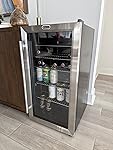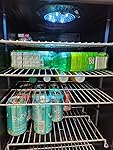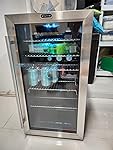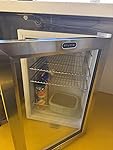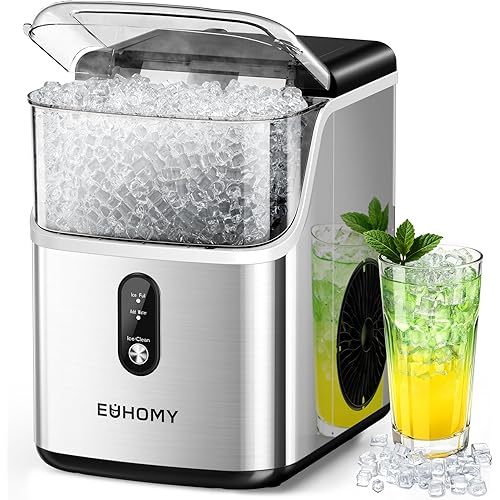Whynter Beverage Refrigerator with Double-Layer Glass Door, 127-Can 3.1 Cu Ft Freestanding Drink Mini Fridge, BR-130SB, Stainless Steel

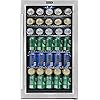








Buy Now, Pay Later
- – 6-month term
- – No impact on credit
- – Instant approval decision
- – Secure and straightforward checkout
Ready to go? Add this product to your cart and select a plan during checkout.
Payment plans are offered through our trusted finance partners Klarna, Affirm, Afterpay, Apple Pay, and PayTomorrow. No-credit-needed leasing options through Acima may also be available at checkout.
Learn more about financing & leasing here.
Selected Option
30-day refund / replacement
To qualify for a full refund, items must be returned in their original, unused condition. If an item is returned in a used, damaged, or materially different state, you may be granted a partial refund.
To initiate a return, please visit our Returns Center.
View our full returns policy here.
Recently Viewed
Size: 3.1 cu. ft.
Color: Stainless steel & Black
Features
- Compact & Spacious Interior: With 3.1 cu. ft. of storage, this small refrigerator cools up to 127 standard 12-oz. cans or accommodates taller bottles using adjustable shelving; Convenient and flexible, it's perfect for dorms, offices, or small spaces
- Sleek, Secure Storage: Our mini refrigerator features an energy efficient double-pane glass door for UV isolation; With a black cabinet and stainless-steel trim, this beverage refrigerator with glass door complements your decor and secures beverages
- Powerful & Quiet Cooling: This small fridge features a powerful compressor and an internal air-cooling system for an evenly cool interior and perfectly chilled drinks; Set this drink fridge's internal temperature anywhere from high 30oF to mid 60oF
- Enhanced Insulation for Consistent Cooling: The perfect mini fridge for offices, dorms and recreation rooms, this beverage fridge features a double-pane glass door with superior insulation that keeps drinks at the ideal temperature and ready to enjoy
- Optimal Organization: This beverage and beer fridge comes with 5 slide-out aluminum shelves that can be easily repositioned to meet your unique storage needs, meaning it's simple organize your drinks by category or size
Description
The Whynter 127-Can Stainless Steel Mini Fridge Cabinet is the ideal choice for compact and efficient beverage display and refrigeration. This drink fridge with glass door is compact, powerful, and ideal for entertaining or meeting your retail merchandising needs. Unlike many small mini fridges, this Whynter mini drink fridge utilizes premium features and design elements to provide a sleek showcase that will be the centerpiece of any space. With its powerful compressor and internal air-cooled system, this this stainless steel mini fridge stays evenly cool and maintains a consistent internal temperatures. An exclusive stainless-steel-trimmed glass door and soft LED lighting allow you to view the contents of this bar fridge while maintaining internal temperatures and increasing energy efficiency. This mini fridge with glass door also features an adjustable temperature range that can be set anywhere from high 30ºF to mid 60º. This free-standing mini beverage fridge comes equipped with 5 slide-out wire shelves. This soda fridge also features a spacious bottom section capable of storing additional cans. Efficiently store all your favorite beverages in one sleek and convenient appliance with the Whynter Freestanding Beverage Refrigerator.
Product Dimensions: 18.75"D x 17"W x 32.5"H
Brand: Whynter
Capacity: 3.1 Cubic Feet
Configuration: Freezerless
Color: Stainless steel & Black
Special Feature: Adjustable Shelves, Internal fan-forced circulation for even temperature distribution throughout the cabinet See more
Installation Type: Freestanding
Number of Doors: 1
Defrost System: Manual
Voltage: 115 Volts
Brand Name: Whynter
Model Info: BR-130SB
Item Weight: 57 pounds
Product Dimensions: 18.75 x 17 x 32.5 inches
Item model number: BR-130SB
Is Discontinued By Manufacturer: No
Capacity: 3.1 Cubic Feet
Annual Energy Consumption: 1 Watts
Freezer Capacity: 1 Cubic Feet
Noise: 44 Decibels
Installation Type: Freestanding
Part Number: BR-130SB
Form Factor: Stand Alone
Special Features: Adjustable Shelves, Internal fan-forced circulation for even temperature distribution throughout the cabinet
Color: Stainless steel & Black
Voltage: 115 Volts
Defrost: Manual
Door Hinges: Reversible
Door Material Type: Stainless Steel
Shelf Type: Wire
Shelves: 5
Certification: ETL
Material Type: Stainless Steel
Included Components: 5 slide-out wire shelves
Batteries Included?: No
Batteries Required?: No
Item Weight: 57 Pounds
Number Of Doors: 1
Date First Available: November 4, 2014
Frequently asked questions
To initiate a return, please visit our Returns Center.
View our full returns policy here.
- Klarna Financing
- Affirm Pay in 4
- Affirm Financing
- Afterpay Financing
- PayTomorrow Financing
- Financing through Apple Pay
Learn more about financing & leasing here.
Similar Products
Top Amazon Reviews
